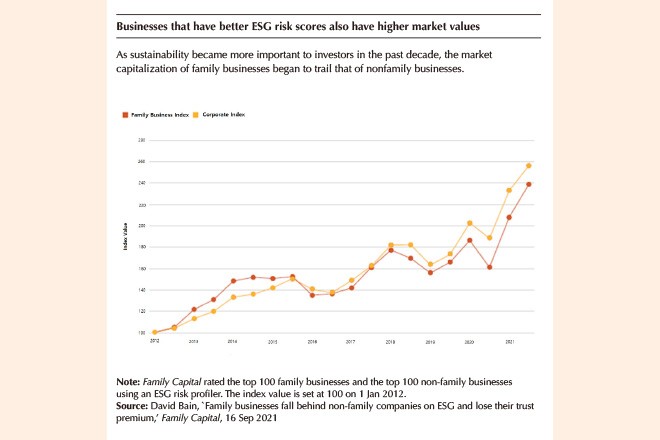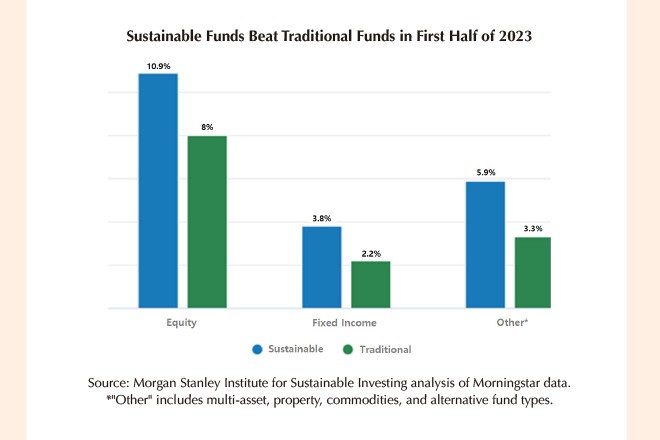[ad_1]
[The content of this article has been produced by our advertising partner.]
Professor Veronique J.A. Lafont-Vinay
Associate Professor, Department of Finance, Department of Business Education
HKUST Business School
Family businesses include a wide range of businesses, from small owner-operated businesses to large publicly traded companies, and contribute significantly to the economies of Asia and the world. According to Deloitte’s Spring 2022 report, in most countries, businesses owned and controlled by families account for two-thirds of all businesses, 70-90% of global annual GDP, and 50-50% of employment. It accounts for 80%. These companies often take a long-term view and have a strong sense of responsibility to their employees, customers, and communities.
Family businesses in Asia are increasingly recognizing the importance of sustainable finance. According to a UBS study, 77% of Asian family businesses consider ESG factors important in investment decisions. This is in line with global trends where sustainable finance is becoming an increasingly important consideration for investors. This article explores the intersection of family businesses and sustainable finance in Asia, and why family businesses can benefit from first-mover advantages in sustainability.
Part I: The rise of sustainable finance
Sustainable finance refers to financial activities that take environmental, social, and governance (ESG) factors into consideration. On the investment side, this includes investments that promote sustainable development, such as renewable energy, green infrastructure, and sustainable agriculture. It also includes integrating ESG factors into investment decision-making processes and measuring the impact of investments on ESG outcomes. On the funding side, this also includes funding decisions related to ESG factors. For example, issuing bonds where the funds raised are used only to finance pre-set environmental projects or borrowing loans whose pricing is made according to the performance of his ESG pre-set KPIs. Etc. .
The rise of sustainable and green finance is also evident in the following developments (Source: S&P Sustainability Focus 2023):
- In terms of issuance size, the sustainable debt and credit market is estimated at between USD 1 trillion and USD 3 trillion at the end of 2021, according to data compiled by Refinitiv and Bloomberg.
- Issuance of green social sustainable bonds and sustainability-linked bonds (GSSSBs) is increasing globally and in the Asia Pacific region (APAC), due to challenging market conditions in the overall bond market and the share of GSSSBs in the total bond market. After falling, it has been increasing.The market continues to expand
- China is accelerating the rise of sustainable finance as a dominant player, especially in the Asia-Pacific region (Source: S&P and Moody’s)
- Buy-side sustainable investment assets are estimated at USD 35 trillion worldwide in 2021.The number of signatories to the Principles for Responsible Investment (PRI) group continues to grow
- In a recent report, Morgan Stanley found that sustainable funds amounted to more than US$3.1 trillion, or 8% of total global assets under management, with 89% in Europe, 10% in the Americas, and less than 2% in the rest of the world. We estimate that there is. Asia still accounts for only 7% of the number of sustainable funds.
- According to Morningstar, the number of sustainable open-end funds and ETFS continues to grow significantly, driven by European influence.
- Sustainable fund growth in Asia ex-Japan continues to be led by China and Singapore, although significantly lower than other regions
Despite the impressive growth of sustainable and green finance, it remains a small part of the overall financial market and only a fraction of the climate finance needs estimated at USD 50 trillion by the World Economic Forum. Not too much. McKinsey estimates that the net-zero transition will require approximately $9.2 trillion annually, or $275 trillion in total. (Source: McKinsey 2022 Recap)
According to S&P, climate change mitigation is a key focus for issuers in the Asia-Pacific region, with renewable energy, green buildings, energy efficiency and transportation accounting for the majority.
Most importantly, many companies are recognizing that climate change creates natural disaster risks to business continuity that may no longer be insurable.
Nevertheless, climate adaptation and climate change offer many opportunities. McKinsey estimates there is a US$12 trillion annual opportunity from net zero plans across a variety of industries.
The rise of sustainable finance is an expression of a deep evolution from shareholder capitalism to stakeholder capitalism. This evolution began with the ‘triple bottom line’ proposed by John Elkington in the 1980s and has accelerated due to the dual impacts of accelerating climate change and climate change. COVID-19 pandemic. The “triple bottom line” (profit, people, planet) was based on the concept of “creating shared value.” This principle of shared value is embedded in the concept of shareholder capitalism (Business Roundtable) and is familiar to family businesses as it is integral to family values.
Part II: Family business and sustainability
1 – The question of values
The very definition of sustainability – “meeting the needs of the present without compromising the ability of future generations to meet their own needs” – aims to balance economic prosperity and legacy with future generations in mind. Consistent with the core intent of a family business founded and maintained by According to his recent KPMG/STEP report, sustainability is now an essential element for businesses around the world and is already embedded in the values of family businesses, which stand to benefit from first-mover advantages. . For many family businesses, sustainability is already a well-traveled path (Source: KPMG/STEP). For example, in Hong Kong, companies such as CLP, Swire and Esquel developed frameworks and goals decades before “sustainability” became a buzzword.
With the latest developments, sustainable finance provides a framework for family businesses, large and small, to align their financial activities with their values and contribute to sustainable development.
2 – Rise of APAC
Family businesses in Asia are increasingly recognizing the importance of sustainable finance. According to a UBS study, 77% of Asian family businesses consider ESG factors important in investment decisions. This is in line with global trends where sustainable finance is becoming an increasingly important consideration for investors.
There are many examples of Asian family businesses riding the wave of sustainable and green finance. Ayala Corporation, a Philippine-based conglomerate with a long history of environmental and social stewardship, has placed sustainability at the core of its business strategy. In 2014, Ayala issued its first green bond, raising US$225 million for renewable energy and energy efficiency projects. Ayala also incorporates ESG factors into his investment decision-making process and has set ambitious sustainability goals for his business operations.
Another example is Hong Kong-based condiment manufacturer Lee Kum Kee Group. Lee Kum Kee has a strong commitment to sustainability and has implemented various initiatives to reduce its impact on the environment. In 2018, Lee Kum Kee issued its first green bond, raising US$150 million for sustainable agriculture and food safety projects. The bond is oversubscribed, demonstrating strong investor demand for sustainable finance in Asia.
One of the attractions of sustainable and ESG financing is its pricing advantages. According to Global Capital, Grinium availability in the Asia-Pacific region will be up to 10 bps in 2022, lower than Europe’s 25 bps, but on the rise. Additionally, issuers can benefit from better enforcement. According to Global Capital, “According to J.P. Morgan, average global oversubscription in dollar terms was 3.8x for green bonds and 2.7x for vanilla deals.” Spread compression averaged 29.3bp for green bonds and 2.7x for vanilla deals. Bonds came in at 22.5bp. ESG trading attracted high quality orders and became more resilient in the secondary market. ”
A study conducted by the CBI (Climate Bond Initiative) in October 2022 also found that green bonds offer pricing benefits and improved liquidity.
Despite the growing interest in sustainable finance among Asian family businesses, there are still significant challenges to overcome. One of the challenges is the lack of standardized ESG reporting and disclosure requirements in the region. This makes it difficult for investors to compare the sustainability performance of different companies and assess the impact of their investments on ESG outcomes. To address this challenge, efforts have been made to develop regional ESG reporting and disclosure standards. For example, the ASEAN Corporate Governance Scorecard includes ESG factors in its assessment of corporate governance practices. The Sustainable Stock Exchanges initiative, which includes Asian stock exchanges, has also developed guidance on ESG reporting and disclosure.
3 – Generational impact
As businesses move from first generation to second or third generation, the role of “NextGen” in driving the sustainability agenda cannot be underestimated. PwC’s Global Next Generation Survey 2022, which surveyed more than 1,036 Next Generation companies, found that 59% believe their family business is moving too slowly towards sustainability; responded that they hope to engage with the world to place greater emphasis on investing in sustainability. future. However, he is only 28% involved at the moment. The most important issue is business growth.
Despite the generational focus on growth, the younger generation is focused on sustainability. Many of these ambitions are being deployed through family offices.
According to PwC Research 2022, 42% of NextGens say they have a family office in their family, and 43% of companies with a family office have a sustainability strategy, compared to 37% of companies without a family office. I answered yes. They are also more likely to have a written constitution and succession plan in place.

Additionally, recent research has shown that a focus on sustainable and green finance can combine profitability and growth objectives with sustainability values, making sustainable funds a good choice for family offices. This is becoming an increasingly attractive option. Recent research from the Morgan Stanley Institute shows that sustainable funds significantly outperform traditional funds.

Conclusion: The importance of education
Another challenge to the uptake of sustainability in Asian family businesses may be the lack of awareness and education about sustainable finance in Asia. Many family businesses may not be aware of the benefits of sustainable finance or how to incorporate ESG factors into their investment decision-making processes.
To address this challenge, efforts have been made in Asia to raise awareness and provide education on sustainable finance. In Hong Kong, the government is encouraging cooperation among all stakeholders to strengthen sustainability efforts and solidify Hong Kong as a leading sustainable financial center.
At HKUST, sustainability extends from research through theme-based research projects in green finance, to undergraduate education through the Bachelor of Science in Sustainability and Green Finance, to executive education through the HKUST X HKGFA Certificate in Sustainability and Green Finance, and On-campus initiatives include the Life Cycle Assessment Lab and the Sustainable & Green Campus, which serves as a living lab through the Sustainable & Net Zero Office.
Family businesses in Asia are increasingly recognizing the importance of sustainable finance. Sustainable Finance provides a framework for family businesses to align their financial activities with their values and contribute to sustainable development. While there are still significant challenges to overcome, there are also opportunities for family businesses to lead the way in sustainable finance in Asia. By integrating ESG factors into investment decision-making processes and measuring the impact of investments on ESG outcomes, family businesses can contribute to a more sustainable and prosperous future for their regions.
[ad_2]
Source link


